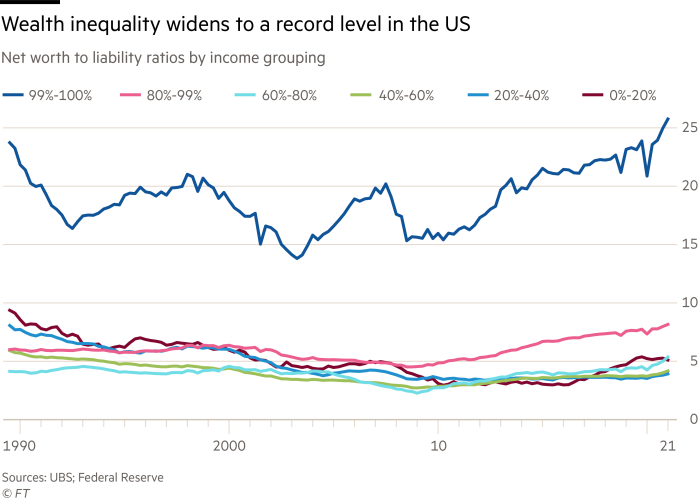
Wealth inequality in the US has reached a record level since the beginning of the coronavirus outbreak, and the Federal Reserve is partially responsible, despite its efforts to boost job prospects for people on low incomes, according to analysts at UBS.
The Fed reacted quickly in 2020 to help cushion the US economy from the devastating effect of lockdowns. But its stimulus has also fired up the price of assets held by the wealthy.
UBS calculations based on Fed data show a ratio measuring individuals’ net assets against their liabilities has climbed dramatically for top earners, as their net worth has rocketed higher alongside a booming stock market.
The net worth of the top 1 per cent of people by income is now close to 26 times their liabilities. For the bottom 20 per cent, it is just over five times, making the difference between the top and bottom its widest on record.
“There has been a surge in inequality that has manifested after Covid,” said Matt Mish, a credit analyst at UBS. “We are driving up wealth for the top earners . . . The Fed is trying to address inequality but by some measures it seems like it is exacerbating it.”
Fed chair Jay Powell has repeatedly noted the patchy recovery in employment between high- and low-paid workers, and stressed a commitment to ensuring the economic recovery does not leave behind those on the bottom end of the income scale.
At a recent conference sponsored by the National Community Reinvestment Coalition, Powell noted that just 6 per cent of workers in the highest earnings quartile in February of 2020 were unemployed one year later. For the lowest quartile, it was close to 20 per cent.
As the Fed acknowledges, this is a tough issue to crack. Speaking to the House financial services committee earlier this month, Powell said wealth inequality rises during a business expansion because people who own assets such as homes and stocks benefit as those assets rise in value.
“Does anyone seriously argue that we should try to stop that from happening by raising rates at the cost of [not] putting people at the bottom end of the income spectrum back to work?” he said. “No. Of course, we wouldn’t do that.”
Alongside fiscal stimulus, it appears that the Fed’s policies have helped lift the net worth of the lowest-income Americans. But middle-income workers now shoulder the most strained net worth to liabilities ratios relative to history.
Mish argues that higher inflation is eroding the ability of middle-income earners to save and improve their financial position.
“Powell is essentially saying that they need to run the economy hot so these lower-income households can get jobs,” he said. “The question is whether that trade-off is worth leaving middle-income households behind, unable to generate savings and net worth, while top earners become even wealthier.”
"feed" - Google News
July 26, 2021 at 10:00AM
https://ift.tt/3iQeZeg
How the Fed’s fine intentions feed US wealth inequality - Financial Times
"feed" - Google News
https://ift.tt/2z3xEQN
https://ift.tt/2yko4c8
Bagikan Berita Ini














0 Response to "How the Fed’s fine intentions feed US wealth inequality - Financial Times"
Post a Comment